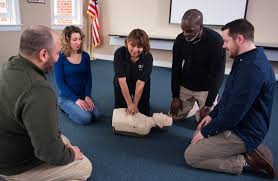Introduction
In today's fast-paced workplace, safety and security is paramount. Organizations are increasingly acknowledging the significance of creating a secure space for workers. One of the most crucial elements of workplace safety and security training is first help and mouth-to-mouth resuscitation (Cardiopulmonary Resuscitation) training courses. These courses not just encourage staff members with essential life-saving skills yet likewise cultivate a society of safety and security within the company. In this short article, we will look into the myriad reasons work environment safety training must consist of first aid and CPR courses, highlighting their relevance in boosting work environment safety.
Why Work environment Security Training Should Consist Of Emergency Treatment and Mouth-to-mouth Resuscitation Courses
The assimilation of emergency treatment and CPR programs into work environment safety and security training has significant advantages. They furnish staff members with the understanding and abilities required to react properly to medical emergency situations, minimize healing time for injured individuals, and potentially save lives. Moreover, having educated workers on-site can infuse confidence amongst workers and reassure them that their well-being is prioritized.
Understanding Initial Aid
First help describes the instant treatment provided to an individual suffering from a minor or serious illness or injury up until professional clinical aid gets here. Comprehending basic emergency treatment principles can make a substantial difference in emergency situations.
Key Parts of First Aid
Assessment: The ability to examine a situation swiftly can assist establish the suitable activities needed. Stabilization: Comprehending how to maintain a wounded individual avoids further harm. Communication: Efficiently interacting with emergency solutions is critical for prompt assistance.The Relevance of CPR
CPR is a life-saving strategy used in emergencies when a person's heartbeat or breathing has stopped. It involves breast compressions and rescue breaths to preserve blood flow and oxygenation until specialist aid arrives.
How CPR Works
- Chest Compressions: These assist flow blood throughout the body. Rescue Breaths: These offer oxygen to the lungs.
Benefits of Emergency treatment and CPR Certification
Obtaining an emergency treatment certification or finishing CPR training courses features numerous advantages, both for individuals and organizations.
Enhanced Staff member Confidence: Workers feel more safe understanding they have life-saving skills. Reduced Recovery Time: Quick feedback with first aid can bring about much better results for hurt individuals. Compliance with Regulations: Lots of industries need qualified employees as part of their health and safety regulations.Creating a Culture of Safety And Security With Training
Implementing emergency treatment and mouth-to-mouth resuscitation training cultivates a society that prioritizes worker well-being.
Encouraging Teamwork
Training sessions frequently include team-building workouts that boost partnership among employees.
Building Trust fund Between Staff members and Management
When management invests in employee training, it shows dedication to their wellness, causing enhanced morale.
First Aid Flows vs. CPR Courses: What's the Difference?
While both sorts of training courses are vital, they concentrate on various ability sets.
First Help Courses
These courses cover a variety of topics beyond just heart emergencies, including:
- Wound care Burns Choking
CPR Courses
CPR programs especially concentrate on strategies connected to cardiac arrest scenarios, stressing:
- Adult CPR Child/ infant resuscitation Use of an Automated External Defibrillator (AED)
Choosing the Right Training Provider
Not all training providers are produced equal; for that reason, selecting one that satisfies your company's needs is critical.
Accreditation Matters
Ensure that your chosen supplier uses accredited programs identified by pertinent authorities.
Instructor Experience
Consider teachers' qualifications; experienced trainers commonly provide richer knowing experiences with real-world examples.
Incorporating Emergency treatment right into Work Environment Safety Policies
Organizations must integrate emergency treatment demands into their more comprehensive safety policies for detailed coverage.
Regular Training Updates
Conducting regular correspondence course guarantees that expertise stays current among employees.
Creating Emergency situation Action Plans
Having clear strategies in position can guide qualified employees during emergencies.

Legal Ramifications of Emergency treatment Training in the Workplace
Employers have legal responsibilities pertaining to office security; implementing emergency treatment training can help minimize threats related to non-compliance.
Negligence Claims
Failure to give sufficient training might leave employers at risk to lawsuits if an occurrence takes place due to absence of preparedness.
FAQ Section
What is included in a typical first aid course?- A typical emergency treatment course consists of guideline on evaluating injuries, treating wounds, handling burns, dealing with choking occurrences, and performing mouth-to-mouth resuscitation if necessary.
- Most CPR training courses last between 4-- 6 hours relying on whether it's standard or advanced training.
- While not constantly legitimately mandated, having actually accredited personnel can substantially improve office safety and security standards.
- Many certified organizations supply on the internet renewal choices for emergency treatment certifications which include assessments using video conferencing.
- Yes, sectors such as building and construction, health care, education and learning, and manufacturing frequently have regulative requirements necessitating qualified employees on site.
- It's recommended that workers participate in correspondence course every 2 years or quicker if there are significant adjustments in treatments or regulations.
Conclusion
To summarize, incorporating first aid and mouth-to-mouth resuscitation right into office safety and security training is not just an alternative but a need in today's work environments where emergencies can arise at any moment. Organizations benefit immensely from having trained personnel ready to nearby first aid training Hobart respond effectively during dilemmas while fostering an atmosphere where staff member health takes precedence over all else. Consequently, it ends up being apparent why workplace safety training need to consist of first aid and CPR programs-- they conserve lives while promoting a proactive technique toward health and wellness requirements within organizations across various sectors.

By focusing on such crucial training campaigns-- first aid certificates gotten with credible companies alongside functional hands-on experience-- business can considerably improve their general emergency situation readiness degrees while additionally constructing more powerful groups capable of tackling any kind of scenario head-on!
